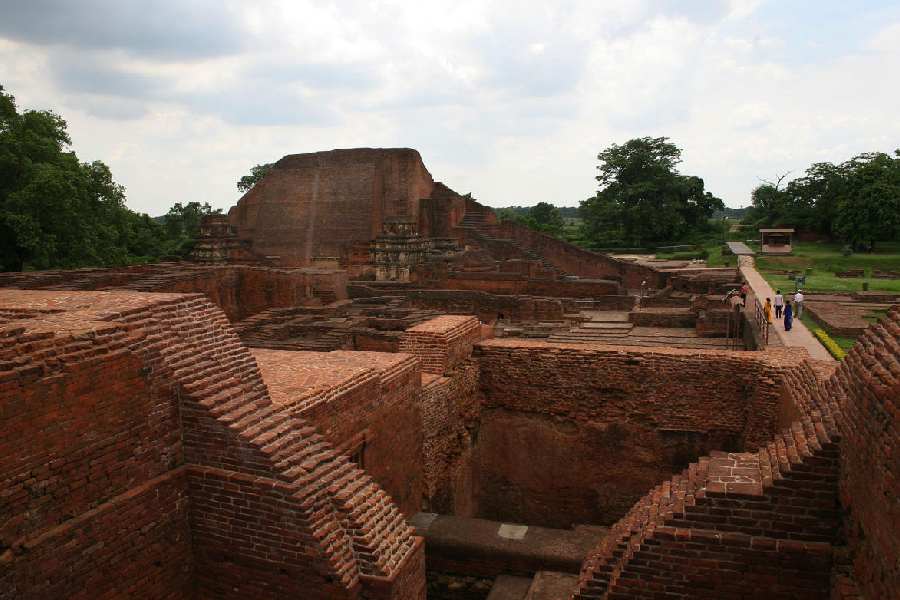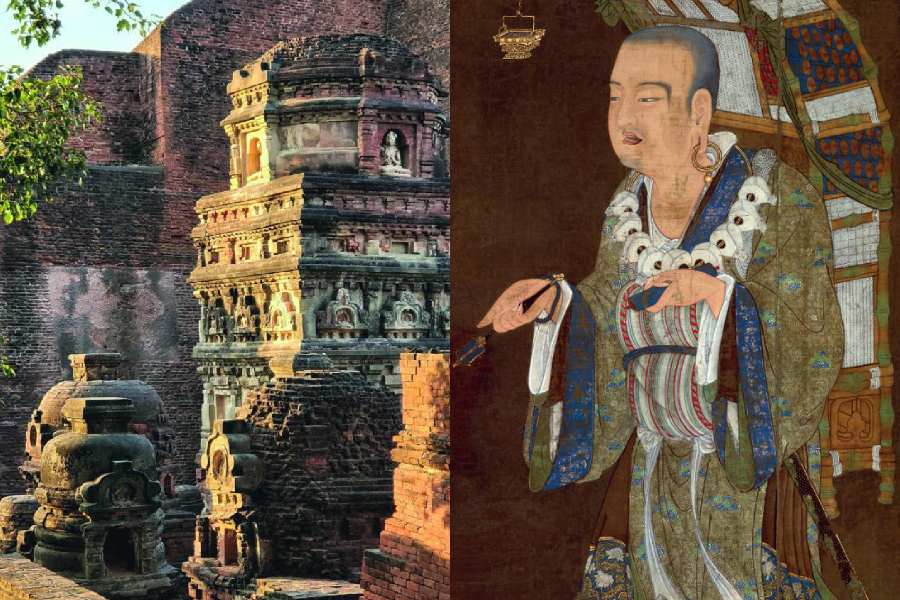Late in the autumn of 629 CE, a tall, well-built man, twenty-nine years old, set off on foot from the walled capital city of Chang’an. He was heading westwards, towards the wastes of the Taklamakan desert and beyond that, so he hoped, over the peaks of the Pamirs.
In many ways the walker could not have chosen a worse time to set off on such an ambitious journey. The country was still in the middle of a civil war, and robbers and brigands haunted the unpoliced roads. To make matters worse, there was also a ban on citizens leaving the country, part of an attempt by the new Tang authorities to stop people joining the insurgent groups lurking in the western border country. But the walker was no rebel. Instead he was an urbane and learned monk, ordained into one of the most philosophical of the Mahayana Buddhist orders.
Xuanzang wanted to travel to the source of the religious tradition to which he had given his life. Specifically, he wanted to enrol at the great Indian Buddhist monastery and university of Nalanda. There he wished to study the manuscripts held in the largest Buddhist library in the world. Nalanda, however, lay 3,000 perilous miles south-west of Chang’an, and getting there would be no easy task, particularly as the Tang authorities had just turned down his application for a travel permit.
Not only was it a time of violent upheaval, it was also the year of a great famine, and there was every likelihood that if the authorities or the brigands did not stop Xuanzang, starvation would. But the monk was well used to taking risks. Although he had been born into a family of elite Confucian scholars and public officials — his great-grandfather had been Governor of Shandong and his grandfather was the head of the Imperial College at Beijing, in reward for which the Emperor had endowed the family with the revenues of an entire town — it was nevertheless Xuanzang’s fate to live in the violent and fractured period between two great dynasties. One, the Sui, was falling and the other, the Tang, had yet fully to establish itself.

OLD MONK: The ruins of Nalanda, the largest Buddhist library in the world of the times. File photo
Xuanzang’s father, a “brilliant and elegant man, with bright eyes, who used to dress himself in the manner of a Confucian scholar”, reacted to the disintegration of his world by immersing himself in the classics. “Anticipating the fall of the Sui, he
buried himself in his study with his books. Many offers of distinguished
positions were pressed on him, which he persistently refused.”
After his death, two of his sons became Buddhist monks, hoping to find within themselves a peace that was notably absent in the world around them. But there was no escape from the endemic violence. In 618, aged thirteen, Xuanzang and his elder brother had had to flee for their lives through the fields along the Yellow River after their monastery in Luoyang was threatened. At this time, according to Xuanzang’s friend and biographer Huili, “the House of Sui lost power, and the country fell into a great turmoil”.
The imperial capital became a nest for brigands like Zhe the Bandit, and the region between the Yellow River and the Luo river turned into a cavern for men as brutal as jackals and wolves. Civilisation collapsed, and the Buddhist community dispersed. White skeletons were scattered at crossroads and the region was depopulated;
no smoke drifted from cooking fires.
Xuanzang was deeply troubled. It was not just that society was disintegrating in front of his eyes; he was worried that the Buddhist tradition he lived and studied was deeply corrupted too. He could see that the texts he used were full of errors and discrepancies. “When he compared editions of the holy scriptures,” wrote Huili, “they showed differences either vaguely or manifestly, so that he was at a loss to decide which of the theories he should follow.” Despite risking his life travelling through the burning countryside from monastery to monastery in search of Buddhist masters who could resolve these inconsistencies, he found none who could adequately answer his questions. Xuanzang felt a growing need “to make further specialised studies and to resolve the contradictions… Thus he resolved to travel to the West, to India, to clear his doubts.”
He had heard that the university monastery of Nalanda contained the fullest and most complete collections of the texts of the tradition known as Yogacara, a spiritual path first outlined by the Gandharan monk Asanga, at the dictation of the Bodhisattva Maitreya, or so the monks maintained.
Asanga maintained that our experience of the world is nothing but an illusion, a misleading creation of our own consciousness. Xuanzang believed the writings of Asanga’s Yogacara school to be the peak of all Buddhist thought, and the one which had preserved the most profound and authentic secrets of his own Mahayana tradition. In particular Xuanzang wished to seek out one specific manuscript — the Yogacarabhumi, “Treatise on the Stages of Yogic Practice”. This was a text for which Xuanzang had been searching all his adult life.
Xuanzang had also heard that at Nalanda the supreme master of Yogacara, a 106-year-old scholar called the Venerable Shilabhadra, was still teaching and, despite his age, taking on new pupils. Ignoring the many dangers, Xuanzang resolved to set off westwards, knowing that centuries earlier other Chinese monks such as Faxian had successfully made the same journey and returned alive, even leaving brief accounts of their journeys. “As the road was obstructed and long,” wrote Xuanzang, “the transmission [of Buddhism to China] was still incomplete… Secretly praying for spiritual protection, I determined to go out from the land of my birth and throw myself into the realm of ten thousand deaths. When passing in the footsteps of the Buddha, I paid my respects to the numinous [presence] he left behind. If there were people who propagated the dharma, I sought out their authentic teaching. When I passed through a place, I was moved to see what I had never seen before. When I encountered a word, I rejoiced at hearing what I had never heard before. In this way, I exhausted my life’s resources to copy texts that were missing at home.”
Xuanzang’s sixteen years of travels, and the different accounts that he, his biographer Huili and his various followers and correspondents have left of his journey, bring to light an entire world that is otherwise lost in shadow and archaeological ambiguity. It is not just that we find ourselves able to draw on a sudden glut of well-verified letters to and from Xuanzang and his learned correspondents; we also have Xuanzang’s own travel book, The Great Tang Dynasty Record of the Western Regions, the most comprehensive account of seventh-century Central Asia and India ever produced, and written with all the care of a sceptical scholar who was unusually scrupulous in matters of fact. “Although it was difficult to exhaustively verify all matters,” he wrote in a postscript, “I never resorted to speculation.” Most remarkable of all, at over 80,000 characters, Huili’s biography, written during his master’s old age and completed after his death, is the fullest single biography to survive from pre-modern China.
These different sources illuminated the intellectual and spiritual bedrock of the Indian ideas that were finding their way over the mountains and deserts and coming to change the way people in China lived and thought. It is one of the richest moments of cultural and philosophical interaction in world history. In the course of China’s first really intimate encounter with an equal civilisation, not only did Buddhism profoundly transform China, bringing about a massive metamorphosis of its arts, history, society and culture at both popular and court levels; at the same time, and no less profoundly, Buddhism was changed and moulded by China.
No one really knows when Buddhism first reached China. Xuanzang himself believed that it had arrived as a result of “a dream of the Emperor of the Han dynasty”. According to this legend, the Chinese Emperor Ming (r.58-75CE) had a vision of a golden being who had a nimbus behind his head that shone like the sun. The Emperor asked his advisers about this strange apparition and was told that in the west there was a deity named the Buddha. “As a result,” wrote Xuanzang, “envoys were sent to the West, and consequently the Right Dharma was transmitted.”
Excerpted with permission from 'The Golden Road: How Ancient India Transformed The World' by William Dalrymple, published by Bloomsbury











